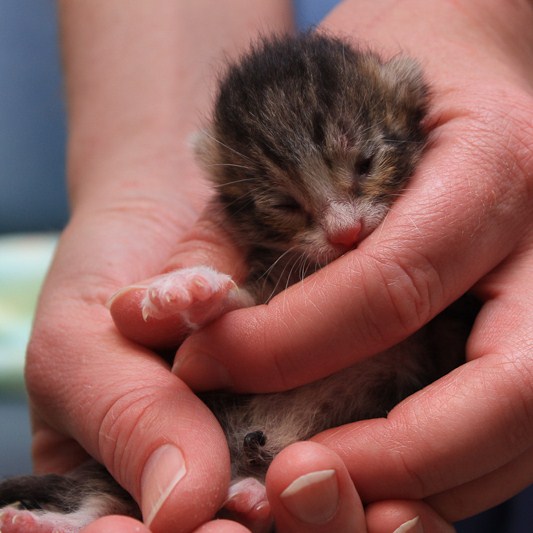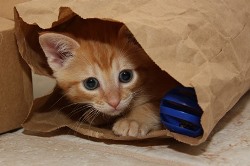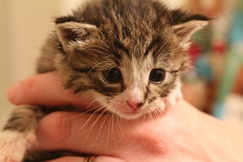
April 2013 by Susan Krebsbach, DVM
Audience: Executive Leadership, Foster Caregivers, Public, Shelter/Rescue Staff & Volunteers, Veterinary Team
 A kitten's development from a helpless, dependent newborn into an independent and agile creature possessing the grace of a skilled acrobat is a rapid yet complex process affected by many factors. For the kitten to develop normally, growth of the cats' musculoskeletal, nervous, organ and mental systems must occur in the correct sequence.
A kitten's development from a helpless, dependent newborn into an independent and agile creature possessing the grace of a skilled acrobat is a rapid yet complex process affected by many factors. For the kitten to develop normally, growth of the cats' musculoskeletal, nervous, organ and mental systems must occur in the correct sequence.
Problems can occur at any developmental stage with far-reaching consequences for the kitten, especially if the kitten is to be a companion to humans. Cats whose behavior falls short of caregiver's expectations are at risk of being surrendered to a shelter.1 Understanding normal kitten development allows us to provide the right environment for those who will share their home with people.
The First Six Weeks of Life
Early behavioral development of kittens is governed by the extent to which other body systems and senses have developed. An understanding of both is vital if we are to comprehend the antics of the kittens in our charge. See Physical and Behavioral Development of Kittens for the First Six Weeks of Life.
Kittens are born relatively helpless. Nursing and sleeping are their only responsibilities; for the most part, they are completely dependent on the mother - whether she boasts four legs or only has two. Eyes sealed shut and ears folded down, they rely on smell, touch and temperature2 for the first two weeks of life. Being incapable of regulating their own body temperature during this time, constant snuggling is a must.
In their second week, kittens are still nursing and sleeping machines but sensory and motor gains allow for some independence from the mother and provide the first thrill of exploration. They rarely stray too far from mother's watchful eye because they now also have the ability to hear - and respond to - her commands. At this time social relationships begin as the kittens sniff, paw at and grooms littermates. Two to seven weeks is the sensitive period for socialization.3
During week three, kitten cuteness emerges in full force. Helplessness turns into curious explorer with a hint of mischievousness. Many sensory systems are developing rapidly; some having already attained their adult state. Nursing and sleeping still occupy the majority of the day but their newly found sensory and motor skills permit more independence. At this age kittens are better at regulating their body temperature and require less snuggling with mother and littermates. Rudimentary walking emerges, providing the wheels for exploration. Social play emerges - life is now a party!
The fourth week brings strength and dexterity - and a keenness for acrobatics. Improved coordination and motor skills lead to some remarkable virtuoso performances. By this age, adult-like hearing, vision and orienting allow kittens to stray farther from the nest. Solitary play declines and group play is more common. Without kitten-proofing, these little artists may wreck havoc on the house.
 As running emerges in week five, kittens seem to be in perpetual motion. Although basic hearing, vision and locomotion are well developed, the kittens still don't have the grace of an adult feline. Typical kitten play involves complex interactions, including hiding while playing. Now is a great time to begin extended human-directed play sessions. Also at this age, kittens are able to successfully use a litter box and their preference for litter type begins to develop.
As running emerges in week five, kittens seem to be in perpetual motion. Although basic hearing, vision and locomotion are well developed, the kittens still don't have the grace of an adult feline. Typical kitten play involves complex interactions, including hiding while playing. Now is a great time to begin extended human-directed play sessions. Also at this age, kittens are able to successfully use a litter box and their preference for litter type begins to develop.
Week six is a time of growth and strengthening of the kitten physique, alongside refinement of sensory-motor skills - and new-found feline shenanigans. They engage in complex social play interactions, like pouncing, going belly-up and side-stepping. At this point, kittens are capable of all adult gaits,4 have full control of elimination functions and eat solid food several times daily. Baby teeth are still erupting - they will chew on everything in the house!
Orphaned Kitten Behavioral Considerations
Mother's Role in Kitten Development
Regardless of species, a mother plays a critical role in the care and development of her babies. Because kittens are born blind and with limited ability to move and regulate body temperature, they are totally dependent on their mother for the first few weeks of life. Good maternal behavior is essential for healthy kitten development - not only for the basics of food, water, shelter and cleaning, but as a role model for survival, rescuing them from danger, and a source of security and emotional development.
Orphaned kittens depend on an alternative for their all-important maternal care. The next best choice is same-species fostering. Although rarely possible, it can be done if a receptive, preferably nursing, feline mom is available. This provides orphans the next best chance for normal development, as long as exposure to people during the critical socialization period is achieved.
In the absence of same-species fostering, these tiny and vulnerable creatures must look to the compassionate heart of human foster parents. These thoughtful and self-sacrificing people take on a demanding job, providing the needed loving care, warmth and socialization to raise orphaned kittens to adoption into their forever home.
Socialization Period (14 Days to 7 Weeks)5
 The socialization period is a critical time in a kitten's behavioral development. Kittens are now most receptive to learning about what should be avoided, ignored or pursued. They begin to explore their environment and learn its hazards and pleasures - and appropriate social behavior towards parents, littermates, other cats and different species. This period is extremely important for learning about the world around them, understanding their relationship with humans and attainment of species-specific social skills.6
The socialization period is a critical time in a kitten's behavioral development. Kittens are now most receptive to learning about what should be avoided, ignored or pursued. They begin to explore their environment and learn its hazards and pleasures - and appropriate social behavior towards parents, littermates, other cats and different species. This period is extremely important for learning about the world around them, understanding their relationship with humans and attainment of species-specific social skills.6
Studies show that early handling of infant animals by humans, although momentarily stressful, has beneficial effects. Accelerated maturation of the central nervous system as well as physical and social development ensue.7 Without adequate human contact during the early months, kittens often become timid, frightened and anxious. Regular, positive interactions with multiple people - from the curious toddler to doting grandma - are essential for kittens to learn to socialize and develop a calm, easygoing temperament. It is also important to expose kittens to all aspects of normal house life during this time in a safe and secure manner.
Potential Behavior Problems of the Orphaned Kitten
Although developmental problems can occur even under the care of their birth mother, without the watchful eye and gentle paw of their feline mom, orphaned kittens are more susceptible to being fearful and aggressive toward people and other cats, more sensitive to novel stimuli, poor learning and deficient social and parenting skills.8, 9 These effects can be lessened with another cat in the household10 and, most importantly, a consistent regime of touch and socialization.
Independence and learning how to deal with minor stressors are important lessons taught by the feline mom, and so orphans typically lack these skills. Instead of encouraging independence as the queen does, many human caretakers mistakenly encourage reliance on themselves. Orphaned kittens may subsequently develop an overly dependent bond with the foster parent, as well as lacking appropriate bite inhibition, prey preference and ability to deal with the trials of everyday life.
Another potential behavior problem of orphaned kittens is nonproductive sucking. This is when a kitten sucks on an object, person or littermate for soothing, non-nutritional purposes - much like a pacifier. Although nonproductive sucking is typically benign, it can cause injury to the object of the kitten's affection - physical harm to the person or littermate and destruction of belongings. In addition, the kitten may ingest something harmful. Often this behavior self-resolves before six to twelve months of age, but it may evolve into a displacement/compulsive behavior.
Recommendations to Prevent Behavioral Problems of Orphaned Kittens
The importance of littermates to the social development of the individual kitten cannot be stressed enough. The presence of littermates, and even older cats, can help modulate the kitten's play behavior so that it is more appropriate. If presented with a single kitten, place her with others of similar age to expose her to the teachings of sibling rivalry.
"Touched by an angel." That's how kittens should feel when experiencing handling by humans. Touch, whether feline or human, is not only calming, healing and pleasurable to the kitten, it is critical for healthy emotional development. Early human handling accelerates development. Research shows that kittens untouched by humans until seven weeks of age are less responsive to people in general. Gently pick kittens up, with one hand under the back legs and the other around the chest, ensuring that they feel safe and secure. Although handling is encouraged from birth, the frequency and length should increase around two to three weeks of age as their physical and behavioral development become more attuned. And don't limit this pleasure to adults. Kittens and kids go together - both love to play and cuddle, after all! With supervision, children can learn to handle kittens appropriately and be respectful of them. It's the start of a mutual admiration society where both benefit.
 Life's a party. A kitten's social life should be a top priority. This is especially important for orphaned kittens because they lack their natural mother's contribution to social development. Therefore, the foster parent will need to take on the social director's role. The need for social interactions starts around two to three weeks of age and intensifies throughout the socialization period, and beyond. Start with short periods (5-10 minutes) of gentle and quiet handling. Stroke bellies, rub behind ears, kiss their blessed heads - be creative, but always gentle and kind. Extend party invitations to friends and family, and kitten-friendly pets. The more variety and number the better. Include three or four people daily in the sphere of handlers to help the kittens build trust. Slowly increase the time spent with them, but not to the point that their sleep is disturbed or kitten-initiated play and exploration is impeded. By the fourth week of life, social play arises and increases until 11 to 14 weeks of age - and a lifetime for some. Now is the time to add play to kitten interactions. Focus on toys that distance the person from the kitten (e.g., pole toys). This encourages independence and stimulates predatory behavior. Never use hands or feet as playthings. Although the "capture" of hands or feet may seem cute, it will be unwelcome as the kitten gets bigger and the ability to cause injury increases. Don't restrict the party to just one area. Kittens need sensory stimulation and some environmental fun. Safely expose them to normal household objects (furniture, appliances, windows) and noises (radio, television, vacuum cleaner, dishwasher), and even short car rides in cat carriers. As their curiosity and maturity expand, expand their environmental fun. Kittens with broader experiences in their first two months are less nervous later in life than those from un-stimulating surroundings.
Life's a party. A kitten's social life should be a top priority. This is especially important for orphaned kittens because they lack their natural mother's contribution to social development. Therefore, the foster parent will need to take on the social director's role. The need for social interactions starts around two to three weeks of age and intensifies throughout the socialization period, and beyond. Start with short periods (5-10 minutes) of gentle and quiet handling. Stroke bellies, rub behind ears, kiss their blessed heads - be creative, but always gentle and kind. Extend party invitations to friends and family, and kitten-friendly pets. The more variety and number the better. Include three or four people daily in the sphere of handlers to help the kittens build trust. Slowly increase the time spent with them, but not to the point that their sleep is disturbed or kitten-initiated play and exploration is impeded. By the fourth week of life, social play arises and increases until 11 to 14 weeks of age - and a lifetime for some. Now is the time to add play to kitten interactions. Focus on toys that distance the person from the kitten (e.g., pole toys). This encourages independence and stimulates predatory behavior. Never use hands or feet as playthings. Although the "capture" of hands or feet may seem cute, it will be unwelcome as the kitten gets bigger and the ability to cause injury increases. Don't restrict the party to just one area. Kittens need sensory stimulation and some environmental fun. Safely expose them to normal household objects (furniture, appliances, windows) and noises (radio, television, vacuum cleaner, dishwasher), and even short car rides in cat carriers. As their curiosity and maturity expand, expand their environmental fun. Kittens with broader experiences in their first two months are less nervous later in life than those from un-stimulating surroundings.
What to do about that unintentional - or sometimes intentional - bite or scratch? The moment the kitten places mouth or claws on human skin, make a sharp yelp (as a crying kitten would) and immediately withdraw, ending the play. This acts as negative punishment, a very effective training tool, teaching the kitten that feline teeth and extended claws mustn't touch human skin. So that you don't send mixed messages, be consistent - don't allow the kitten to play bite sometimes and not others. It is challenging to act quickly and with just the right amount of force to stop inappropriate behavior, as another kitten or the queen would. Regardless, inflict no physical punishment. No exceptions. It has a great potential to cause fear and/or aggression in the kitten. If the kitten continues to pursue, calmly pick him up and place him in a separate, kitten-proof area for about five minutes as a form of a "timeout." Although the kitten is not likely to associate the timeout in another room with the act of biting or scratching, it will give the kitten an opportunity to calm down.
Kittens whose nonproductive sucking is excessive may benefit from an enriched environment with many items to suck or chew. Examples include rawhides soaked in water, cat grass, beef jerky, food stuffed toys and chewy or dry food. Furthermore, if the kitten shows a preference for a certain (and appropriate) item, reward her only when she sucks on that object. For example, if the kitten has a fancy for cotton, an old cotton towel can be given to her so that she will have an appropriate item to suck on. Then, when the kitten starts sucking on the person's skin or clothing, place her on the floor and give the kitten the old cotton towel to suck on. Or better yet, redirect the kitten to a completely different appropriate behavior, like playing with a pole toy. Never punish this behavior; it can be anxiety based and physical punishment only increases conflict - leading to more undesirable behaviors. In addition, it should not be encouraged through petting or other positive reinforcement.
Suckling on the body parts of littermates is seen more commonly in kittens who lost their mother at around two weeks of age but were used to suckling on demand. In this case, the only solution is to separate the littermates until 4-5 weeks of age, when their suckling urge typically decreases. During the time of separation, make sure the littermates have supervised playtime with one another.
Conclusion
The reward of watching an orphaned kitten grow from a helpless baby to a loving and playful human companion is priceless. Understanding the behavioral development of kittens, and its link to physical development, is a critical part of this process. It allows us to address the special behavioral considerations of the orphaned kitten - and prepare her for a life embraced by the arms, and heart, of a two-legged companion.
After reading this article, click here to take the quiz and receive a Certificate of Attendance!
References:
1. Patronek G, Glickman L, Beck A, et al. Risk factors for relinquishment of cats to an animal shelter. Journal of the American Veterinary Medical Association, 1996, vol 209, p. 582.
2. Beaver BV. Feline Behavior of Sensory and Neural Origin. Feline Behavior: A Guide for Veterinarians; Philadelphia, PA; W.B. Saunders Company; 1992; p. 15-62.
3. Radosta L. Feline behavioral development. Peterson ME, Kutzler MA, eds. Small Animal Pediatrics; St. Louis, MO; Elsevier Saunders; 2011; p. 88-96.
4. Bateson P. Behavioural development in the cat. Turner DC, Bateson P, eds. The Domestic Cat: the biology of its behaviour, ed 2, Cambridge, Cambridge University Press, 2000, p. 9.
5. Landsberg G, Ley PM. Kitten Development. Little, S, eds. The Cat: Clinical Medicine and Management; St. Louis, MO; Elsevier Saunders; 2012; p. 184.
6. Zambelli D. Feline Neonatal Physiology, Behavior, and Socialization. Lopate C, eds. Management of Pregnant and Neonatal Dogs, Cats, and Exotic Pets; Ames, IA; Wiley-Blackwell; 2012; p. 156.
7. Karsh EB, Turner DC. The human-cat relationship. Turner DC, Bateson P, eds. The Domestic Cat: the biology of its behaviour, Cambridge, Cambridge University Press, 1988, p. 159-177.
8. Mellen J. Effects of early rearing experience on subsequent adult sexual behavior using domestic cats (Felis catus) as a model for exotic small felids. Zoo Biol., 1992, p. 11-17.
9. Seitz PFD. Infantile experience and adult behavior in animal subjects: II. Age of separation from the mother and adult behavior in the cat. Psychosom Med., 1959, vol 21, p. 353.
10. Chon E: The effects of queen (Felis sylvestris)-rearing versus hand-rearing on feline aggression and other problematic behaviors. Mills D, Levine E, et al, eds. Current issues and research in veterinary behavioral medicine; West Lafayette, IN; Purdue University Press; 2005; p. 201-202.

Susan Krebsbach, DVM
Dr. Susan Krebsbach graduated from The Ohio State University College of Veterinary Medicine in 1995. After working as a small animal general practitioner for several years, she started concentrating her efforts on animal behavior, opening a veterinary animal behavior consulting service called Creature Counseling in 2000.
In addition to her behavior consulting service, Dr. Krebsbach is a veterinary consultant for Maddie's Fund® and the Humane Society Veterinary Medical Association, a featured speaker for professional and animal rescue organizations, and author of several articles on animal behavior. In addition, she is the founder of Dane County Friends of Ferals and has volunteered her services to several animal rescue organizations. For these efforts, Dr. Krebsbach has been recognized with various awards.
Dr. Krebsbach is truly dedicated to enhancing the special relationship between pets and their people, and advocating for the well-being of all animals.